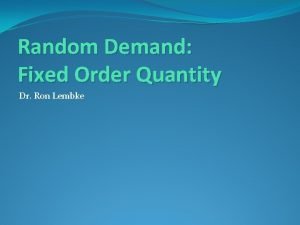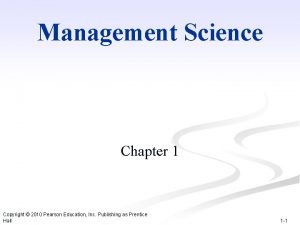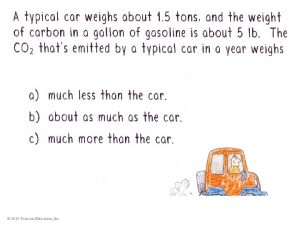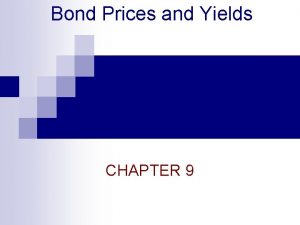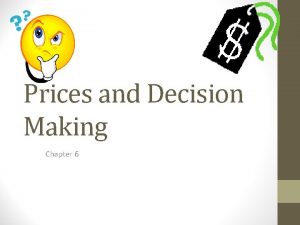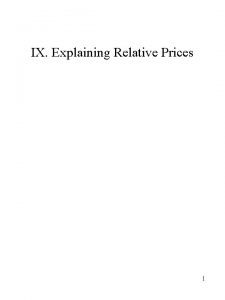2010 Pearson AddisonWesley 2010 Pearson AddisonWesley Fixed Prices




















































- Slides: 52

© 2010 Pearson Addison-Wesley

© 2010 Pearson Addison-Wesley

Fixed Prices and Expenditure Plans Keynesian model describes the economy in the very short run when prices are fixed. Because each firm’s price is fixed, for the economy as a whole: 1. The price level is fixed. 2. Aggregate demand determines real GDP. What determines aggregate expenditure plans? © 2010 Pearson Addison-Wesley

Fixed Prices and Expenditure Plans The components of aggregate expenditure sum to real GDP. That is, Y=C+I+G+X–M Two of the components of aggregate expenditure, consumption and imports, are influenced by real GDP. So there is a two-way link between aggregate expenditure and real GDP. © 2010 Pearson Addison-Wesley

Fixed Prices and Expenditure Plans Two-Way link Between Aggregate Expenditure and Real GDP Other things remaining the same, < An increase in real GDP increases aggregate expenditure. < An increase in aggregate expenditure increases real GDP. © 2010 Pearson Addison-Wesley

Fixed Prices and Expenditure Plans Consumption and Saving Plans Consumption expenditure is influenced by many factors but the most direct one is disposable income. Disposable income is aggregate income or real GDP, Y, minus net taxes, T. Call disposable income YD. The equation for disposable income is YD = Y – T © 2010 Pearson Addison-Wesley

Fixed Prices and Expenditure Plans Disposable income is either spent on consumption goods and services, C, or saved, S. That is, YD = C + S. The relationship between consumption expenditure and disposable income, other things remaining the same, is the consumption function. The relationship between saving and disposable income, other things remaining the same, is the saving function. © 2010 Pearson Addison-Wesley

Fixed Prices … Figure 11. 1 illustrates the consumption function … and the saving function. When consumption expenditure exceeds disposable income, saving negative (dissaving). When consumption expenditure is less than disposable income, there is saving. © 2010 Pearson Addison-Wesley

Fixed Prices and Expenditure Plans Marginal Propensity to Consume The marginal propensity to consume (MPC) is the fraction of a change in disposable income spent on consumption. It is calculated as the change in consumption expenditure, C, divided by the change in disposable income, YD, that brought it about. That is, MPC = C ÷ YD © 2010 Pearson Addison-Wesley

Fixed Prices and Expenditure Plans Figure 11. 2(a) shows that the MPC is the slope of the consumption function. Along this consumption function, when disposable income increases by $2 trillion, consumption expenditure increases by $1. 5 trillion. The MPC is 0. 75. © 2010 Pearson Addison-Wesley

Fixed Prices and Expenditure Plans Marginal Propensity to Save The marginal propensity to save (MPS) is the fraction of a change in disposable income that is saved. It is calculated as the change in saving, S, divided by the change in disposable income, YD, that brought it about. That is, MPS = S ÷ YD © 2010 Pearson Addison-Wesley

Fixed Prices and Expenditure Plans Figure 11. 2(b) shows that the MPS is the slope of the saving function. Along this saving function, when disposable income increases by $2 trillion, saving increases by $0. 5 trillion. The MPC is 0. 25. © 2010 Pearson Addison-Wesley

Fixed Prices and Expenditure Plans The MPC plus the MPS equals 1. To see why, note that, C + S = YD. Divide this equation by YD to obtain, C/ YD + S/ YD = YD/ YD or MPC + MPS = 1. © 2010 Pearson Addison-Wesley

Fixed Prices and Expenditure Plans Consumption as a Function of Real GDP Disposable income changes when either real GDP changes or net taxes change. If tax rates don’t change, real GDP is the only influence on disposable income, so consumption expenditure is a function of real GDP. We use this relationship to determine real GDP when the price level is fixed. © 2010 Pearson Addison-Wesley

Fixed Prices and Expenditure Plans Import Function In the short run, U. S. imports are influenced primarily by U. S. real GDP. The marginal propensity to import is the fraction of an increase in real GDP spent on imports. In recent years, NAFTA and increased integration in the global economy have increased U. S. imports. Removing the effects of these influences, the U. S. marginal propensity to import is probably about 0. 2. © 2010 Pearson Addison-Wesley

Real GDP with a Fixed Price Level When the price level is fixed, aggregate demand is determined by aggregate expenditure plans. Aggregate planned expenditure is planned consumption expenditure plus planned investment plus planned government expenditure plus planned exports minus planned imports. © 2010 Pearson Addison-Wesley

Real GDP with a Fixed Price Level Planned consumption expenditure and planned imports are influenced by real GDP. When real GDP increases, planned consumption expenditure and planned imports increase. Planned investment plus planned government expenditure plus planned exports are not influenced by real GDP. We’re going to study the aggregate expenditure model that explains how real GDP is determined when the price level is fixed. © 2010 Pearson Addison-Wesley

Real GDP with a Fixed Price Level The Aggregate Expenditure Model The relationship between aggregate planned expenditure and real GDP can be described by an aggregate expenditure schedule, which lists the level of aggregate expenditure planned at each level of real GDP. The relationship can also be described by an aggregate expenditure curve, which is a graph of the aggregate expenditure schedule. © 2010 Pearson Addison-Wesley

Real GDP with a Fixed Price Level Aggregate Planned Expenditure Figure 11. 3 shows how the aggregate expenditure curve (AE) is built from its components. © 2010 Pearson Addison-Wesley

Real GDP with a Fixed Price Level Consumption expenditure minus imports, which varies with real GDP, is induced expenditure. The sum of investment, government expenditure, and exports, which does not vary with GDP, is autonomous expenditure. (Consumption expenditure and imports can have an autonomous component. ) © 2010 Pearson Addison-Wesley

Real GDP with a Fixed Price Level Actual Expenditure, Planned Expenditure, and Real GDP Actual aggregate expenditure is always equal to real GDP. Aggregate planned expenditure may differ from actual aggregate expenditure because firms can have unplanned changes in inventories. Equilibrium Expenditure Equilibrium expenditure is the level of aggregate expenditure that occurs when aggregate planned expenditure equals real GDP. © 2010 Pearson Addison-Wesley

Real GDP with a Fixed Price Level Figure 11. 4 illustrates equilibrium expenditure. Equilibrium occurs at the point at which the aggregate expenditure curve crosses the 45° line in part (a). Equilibrium occurs when there are no unplanned changes in business inventories in part (b). © 2010 Pearson Addison-Wesley

Real GDP with a Fixed Price Level Convergence to Equilibrium If aggregate planned expenditure exceeds real GDP (the AE curve is above the 45° line), … there is an unplanned decrease in inventories. To restore inventories, firms hire workers and increase production. Real GDP increases. © 2010 Pearson Addison-Wesley

Real GDP with a Fixed Price Level If aggregate planned expenditure is less than real GDP (the AE curve is below the 45° line), … there is an unplanned increase in inventories. To reduce inventories, firms fire workers and decrease production. Real GDP decreases. © 2010 Pearson Addison-Wesley

Real GDP with a Fixed Price Level If aggregate planned expenditure equals real GDP (the AE curve intersects the 45° line), … there is no unplanned change in inventories. So firms maintain their current production. Real GDP remains constant. © 2010 Pearson Addison-Wesley

The Multiplier The multiplier is the amount by which a change in autonomous expenditure is magnified or multiplied to determine the change in equilibrium expenditure and real GDP. © 2010 Pearson Addison-Wesley

The Multiplier The Basic Idea of the Multiplier An increase in investment (or any other component of autonomous expenditure) increases aggregate expenditure and real GDP. The increase in real GDP leads to an increase in induced expenditure. The increase in induced expenditure leads to a further increase in aggregate expenditure and real GDP. So real GDP increases by more than the initial increase in autonomous expenditure. © 2010 Pearson Addison-Wesley

The Multiplier Figure 11. 5 illustrates the multiplier. An increase in autonomous expenditure brings an unplanned decrease in inventories. So firms increase production and real GDP increases to a new equilibrium. © 2010 Pearson Addison-Wesley

The Multiplier Why Is the Multiplier Greater than 1? The multiplier is greater than 1 because an increase in autonomous expenditure induces further increases in aggregate expenditure. The Size of the Multiplier The size of the multiplier is the change in equilibrium expenditure divided by the change in autonomous expenditure. © 2010 Pearson Addison-Wesley

The Multiplier and the Slope of the AE Curve The slope of the AE curve determines the magnitude of the multiplier: Multiplier = 1 ÷ (1 – Slope of AE curve) If the change in real GDP is DY, the change in autonomous expenditure is DA, and the change in induced expenditure is DN, then Multiplier = DY ÷ DA © 2010 Pearson Addison-Wesley

The Multiplier To see why the multiplier = 1 ÷ (1 – Slope of AE curve), begin with the fact that: DY = DN + DA But Slope of AE curve = DN ÷ DY so, DN = (Slope of AE curve x DY) and DY = (Slope of AE curve x DY) + DA © 2010 Pearson Addison-Wesley

The Multiplier Because DY = (Slope of AE curve x DY) + DA you can see that (1 - Slope of AE curve) x DY = DA and DY = DA ÷ (1 - Slope of AE curve) © 2010 Pearson Addison-Wesley

The Multiplier The multiplier is DY ÷ DA So, divide both sides of DY = DA ÷ (1 - Slope of AE curve) by DA to obtain DY ÷ DA = 1 ÷ (1 - Slope of AE curve) © 2010 Pearson Addison-Wesley

The Multiplier With the numbers in Figure 11. 5, the slope of the AE curve is 0. 75, so the multiplier is DY ÷ DA = 1 ÷ (1 - 0. 75) = 1 ÷ (0. 25) = 4. When there are no income taxes and no imports, the slope of the AE curve equals the marginal propensity to consume, so the multiplier is Multiplier = 1 ÷ (1 - MPC). But 1 – MPC = MPS, so the multiplier is also Multiplier = 1 ÷ MPS. © 2010 Pearson Addison-Wesley

The Multiplier Imports and Income Taxes Both imports and income taxes reduce the size of the multiplier. Figure 11. 6 shows how. In part (a) with no taxes or imports, the slope of the AE curve is 0. 75 and the multiplier is 4. © 2010 Pearson Addison-Wesley

The Multiplier In part (b), with taxes and imports, the slope of the AE curve is 0. 5 and the multiplier is 2. © 2010 Pearson Addison-Wesley

The Multiplier Process Figure 11. 7 illustrates the multiplier process. The MPC determines the magnitude of the amount of induced expenditure at each round as aggregate expenditure moves toward equilibrium expenditure. © 2010 Pearson Addison-Wesley

The Multiplier Business Cycle Turning Points Turning points in the business cycle—peaks and troughs— occur when autonomous expenditure changes. An increase in autonomous expenditure brings an unplanned decrease in inventories, which triggers an expansion. A decrease in autonomous expenditure brings an unplanned increase in inventories, which triggers a recession. © 2010 Pearson Addison-Wesley

The Multiplier and the Price Level Adjusting Quantities and Prices Real firms don’t hold their prices constant for long. When firms have an unplanned change in inventories, they change production and prices. And the price level changes when firms change prices. The aggregate supply-aggregate demand model explains the simultaneous determination of real GDP and the price level. The two models are related. © 2010 Pearson Addison-Wesley

The Multiplier and the Price Level Aggregate Expenditure and Aggregate Demand The aggregate expenditure curve is the relationship between aggregate planned expenditure and real GDP, with all other influences on aggregate planned expenditure remaining the same. The aggregate demand curve is the relationship between the quantity of real GDP demanded and the price level, with all other influences on aggregate demand remaining the same. © 2010 Pearson Addison-Wesley

The Multiplier and the Price Level Deriving the Aggregate Demand Curve When the price level changes, a wealth effect and substitution effects change aggregate planned expenditure and change the quantity of real GDP demanded. Figure 11. 8 on the next slide illustrates the effects of a change in the price level on the AE curve, equilibrium expenditure, and the quantity of real GDP demanded. © 2010 Pearson Addison-Wesley

The Multiplier and the Price Level In Figure 11. 8(a), a rise in price level from 115 to 135 … shifts the AE curve from AE 0 downward to AE 1 and decreases the equilibrium expenditure from $12 trillion to $11 trillion. © 2010 Pearson Addison-Wesley

The Multiplier and the Price Level In Figure 11. 8(b), the same rise in the price level that lowers equilibrium expenditure … brings a movement along the AD curve from point B to point A. © 2010 Pearson Addison-Wesley

The Multiplier and the Price Level A fall in price level from 115 to 95 … shifts the AE curve from AE 0 upward to AE 2 and increases equilibrium expenditure from $12 trillion to $13 trillion. © 2010 Pearson Addison-Wesley

The Multiplier and the Price Level The same fall in the price level that increases equilibrium expenditure … brings a movement along the AD curve to from point B to point C. © 2010 Pearson Addison-Wesley

The Multiplier and the Price Level Points A, B, and C on the AD curve correspond to the equilibrium expenditure points A, B, and C at the intersection of the AE curve and the 45° line. © 2010 Pearson Addison-Wesley

The Multiplier and the Price Level Changes in Aggregate Expenditure and Aggregate Demand Figure 11. 9 illustrates the effects of an increase in investment. The AE curve shifts upward … …and the AD curve shifts rightward … by an amount equal to the change in investment multiplied by the multiplier. © 2010 Pearson Addison-Wesley

The Multiplier and the Price Level Equilibrium Real GDP and the Price Level Figure 11. 10 shows the effect of an increase in investment in the short run when the price level changes and the economy moves along its SAS curve. © 2010 Pearson Addison-Wesley

The Multiplier and the Price Level The increase in investment shifts the AE curve upward and shifts the AD curve rightward. With no change in the price level, real GDP would increase to $14 trillion at point B. © 2010 Pearson Addison-Wesley

The Multiplier and the Price Level But the price level rises. The AE curve shifts downward…. Equilibrium expenditure decreases to $13. 3 trillion… As the price level rises, real GDP increases along the SAS curve to $13. 3 trillion. The multiplier in the short run is smaller than when the price level is fixed. © 2010 Pearson Addison-Wesley

The Multiplier and the Price Level Figure 11. 11 illustrates the long-run effects. At point C in part (b), there is an inflationary gap. The money wage rate starts to rise and the SAS curve starts to shift leftward. © 2010 Pearson Addison-Wesley

The Multiplier and the Price Level The money wage rate will continue to rise and the SAS curve will continue to shift leftward, until real GDP equals potential real GDP. In the long run, the multiplier is zero. © 2010 Pearson Addison-Wesley
 Fixed order quantity
Fixed order quantity Four types of reinforcement schedules
Four types of reinforcement schedules Fixed function ic
Fixed function ic Insight theory
Insight theory Fixed interval vs variable interval
Fixed interval vs variable interval Copyright 2010 pearson education inc
Copyright 2010 pearson education inc 2010 pearson education inc answers
2010 pearson education inc answers Copyright 2010 pearson education inc
Copyright 2010 pearson education inc Two coins rotate on a turntable
Two coins rotate on a turntable Copyright 2010 pearson education inc
Copyright 2010 pearson education inc 2010 pearson education inc
2010 pearson education inc 2010 pearson education inc answers
2010 pearson education inc answers 2010 pearson education inc
2010 pearson education inc 2010 pearson education inc answers
2010 pearson education inc answers Pearson education inc. publishing as prentice hall
Pearson education inc. publishing as prentice hall Copyright 2010 pearson education inc
Copyright 2010 pearson education inc 2010 pearson education inc
2010 pearson education inc 2010 pearson education inc
2010 pearson education inc 2010 pearson education inc answers
2010 pearson education inc answers Income statement example pearson
Income statement example pearson 2010 pearson education inc
2010 pearson education inc 2010 pearson education inc answers
2010 pearson education inc answers Copyright 2010 pearson education inc
Copyright 2010 pearson education inc 2010 pearson education inc
2010 pearson education inc 2010 pearson education inc
2010 pearson education inc Pearson education inc all rights reserved
Pearson education inc all rights reserved 2010 pearson education inc
2010 pearson education inc 2010 pearson education inc
2010 pearson education inc Pearson education inc 5
Pearson education inc 5 Reorder point formula example
Reorder point formula example Copyright 2010 pearson education inc
Copyright 2010 pearson education inc 2010 pearson education inc answers
2010 pearson education inc answers Copyright 2010 pearson education inc
Copyright 2010 pearson education inc Pearson 2010
Pearson 2010 Copyright 2010 pearson education inc
Copyright 2010 pearson education inc 2010 pearson education inc
2010 pearson education inc 2010 pearson education inc
2010 pearson education inc 2010 pearson education inc answers
2010 pearson education inc answers 2010 pearson education inc
2010 pearson education inc 2010 pearson education inc
2010 pearson education inc Stress management for life 5th edition
Stress management for life 5th edition Pearson education inc publishing as pearson prentice hall
Pearson education inc publishing as pearson prentice hall Pearson education inc. publishing as prentice hall
Pearson education inc. publishing as prentice hall Pearson education inc publishing as pearson prentice hall
Pearson education inc publishing as pearson prentice hall Pearson education inc publishing as pearson prentice hall
Pearson education inc publishing as pearson prentice hall Pearson vue president
Pearson vue president 2012 pearson education inc
2012 pearson education inc Springwest academy
Springwest academy Putt wetherbee
Putt wetherbee Teleast internet prices
Teleast internet prices Steve keen
Steve keen Usps prices 2015
Usps prices 2015 Rising food prices causes and consequences
Rising food prices causes and consequences
